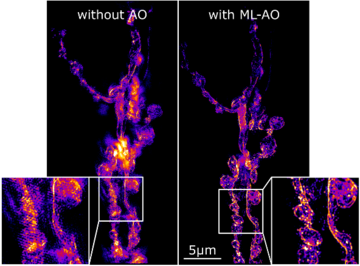Dr Qi Hu’s passion for light and innovative use of AI is improving image quality of optical microscopy for biological samples. An Eric and Wendy Schmidt AI in Science Fellow, Qi uses neural network computations to enable new depths of research in biological sciences.
Qi developed a strong interest in light from a young age: “Light is unlike anything that is tangible. We can see it and feel it, but we do not know what it is”. Her new ideas led her to work in adaptive optics. Adaptive optics is a particularly interesting way of looking at light; as Qi explains, “you can finely manipulate light properties, and when seen on a camera, the effect of adaptive optics is almost like giving light a tangible shape.”
Much of Qi’s work involves simulations, because the experiments require biological samples which are a precious commodity. Simulations (or ‘digital twins’) provide predictions for method development and experimental designs before verifying in real systems on real samples. She is excited when her experimental results agree with her simulations, but even more so when biologists use her methods and verify that these help them see better, deeper, and clearer imaging within biological organelles.

Qi's work shows the difference possible when using ML-AO in improving image quality in super-resolution optical nanoscopy
Using AI felt like a natural progression for Qi. In her work with neuroscientists, she has learnt a lot about how the brain works, how neural circuits were constructed, and information is processed. She goes on to say “One thing that was interesting for me to learn is how our eyes and our brain can so easily conduct pattern separations to detect any subtle changes. This inspired me to learn and design neural network computations to teach our microscopes to do the same”. Modulating light is a fine control and its effects lead to significant changes to subtle features. Qi uses AI to develop a smart microscope that can automatically detect these changes and manipulate light in response. She notes that AI is not a magic wand for scientists; it is a flexible and powerful tool, but with limitations and downsides. She highlights the importance of understanding the nature of the problem to determine whether AI is the right tool to use.
Incorporating AI into her research has changed Qi’s research trajectory; her work in machine learning embedded adaptive optics (ML-AO) has attracted commercial interest, and she now works with commercial partners and Oxford University Innovation to seek market opportunities. This has broadened her work experience and challenged her thinking in terms of research direction. Qi is now looking into new ways of processing information and exploring optical computing for more efficient use of photonic data and energy. “One very interesting finding from my ML-AO work is that neural networks can become transparent if designed carefully with physical knowledge. I designed the neural network architecture in such a way that interesting information about how machine process information can be extracted to understand why system works in certain ways.”
Qi enjoys working with and learning from colleagues across different fields and appreciates how understanding one system can lead to advancements in many other areas of technology. She hopes to develop her collaborations to further improve the quality of optical microscopy.